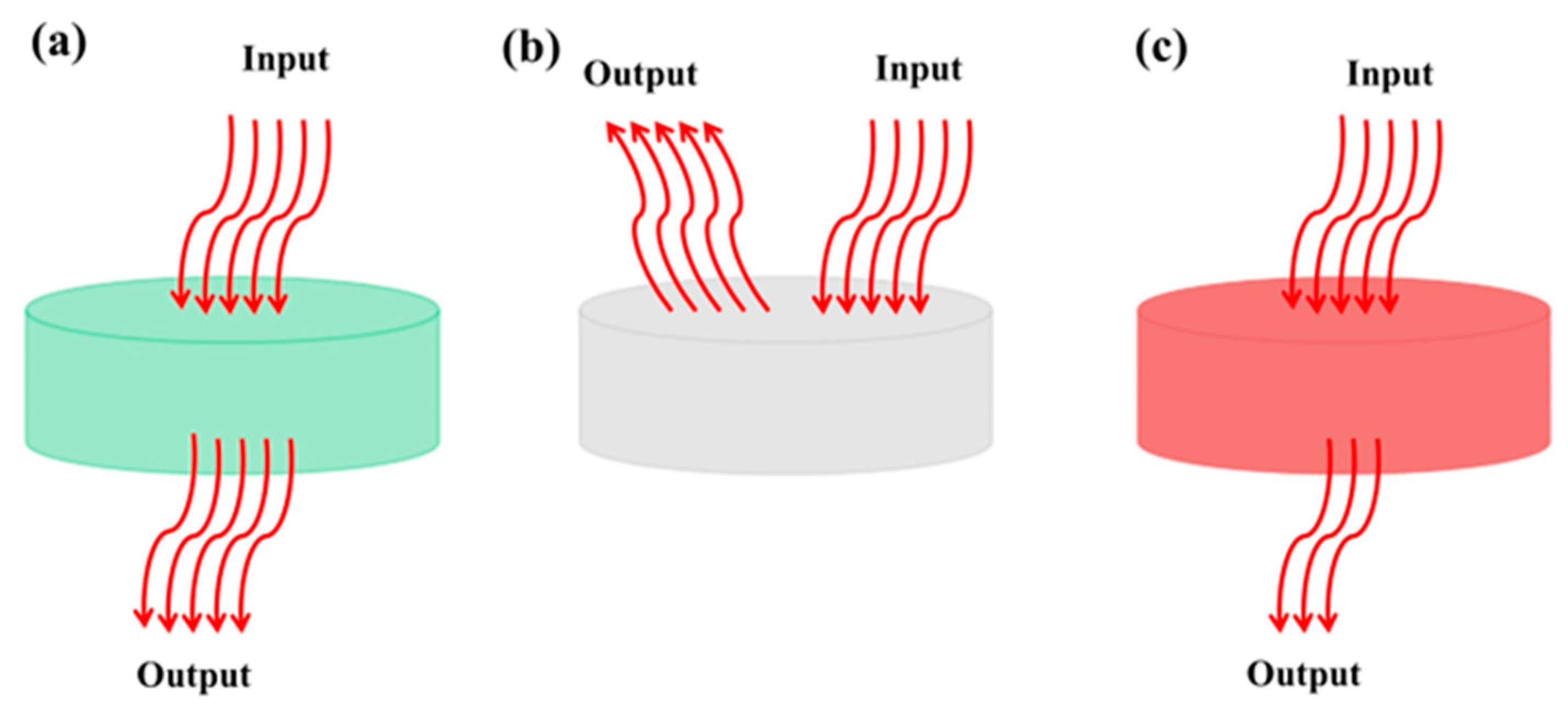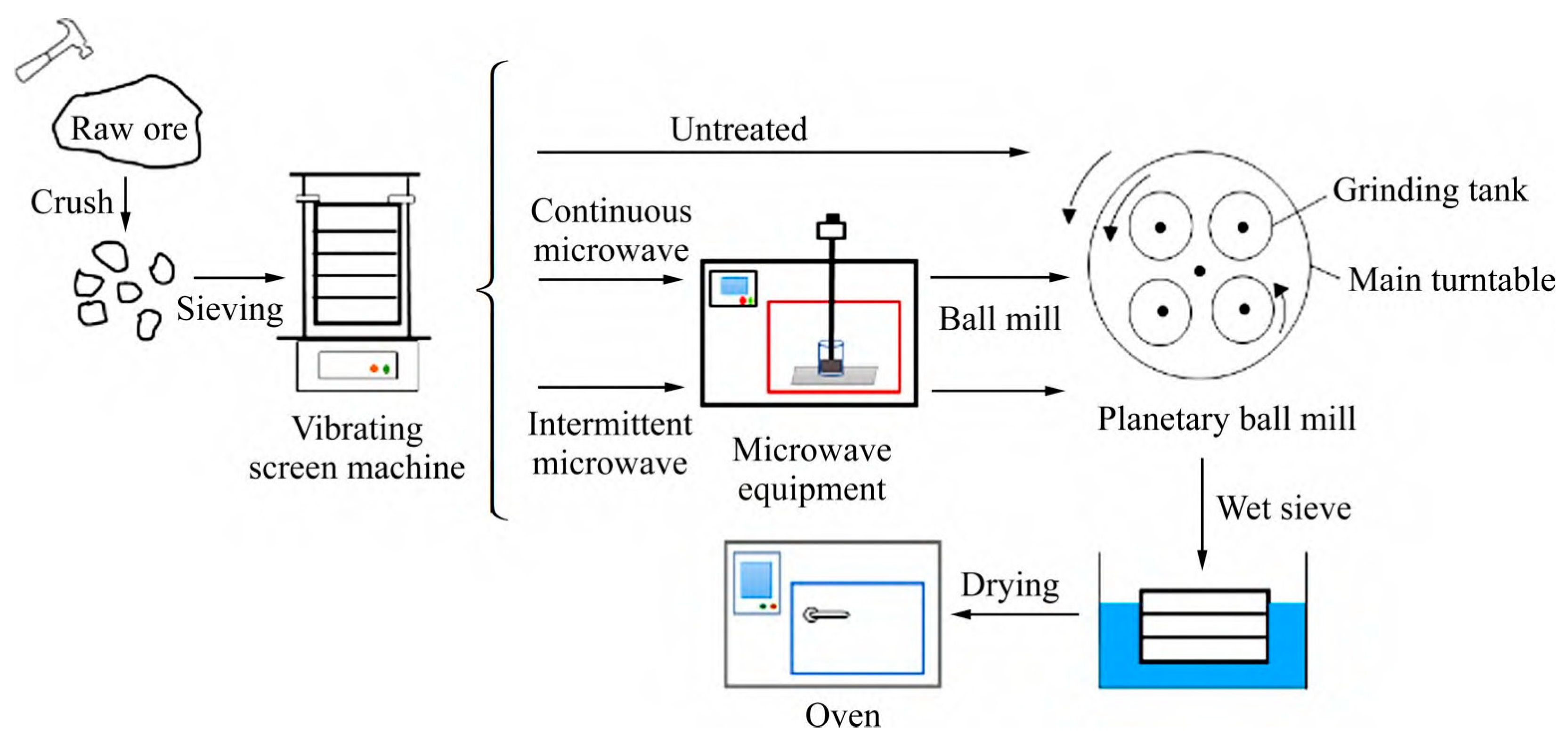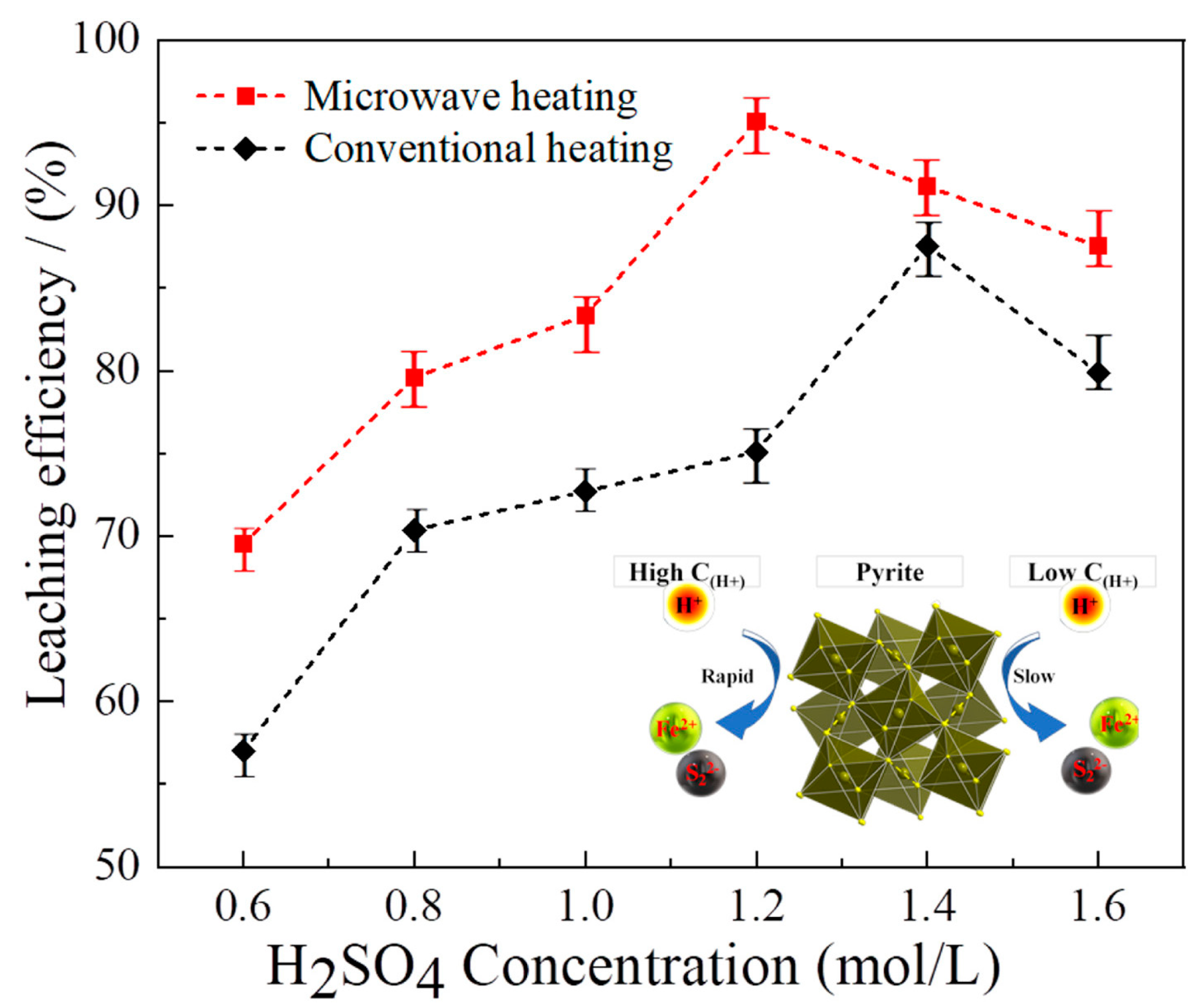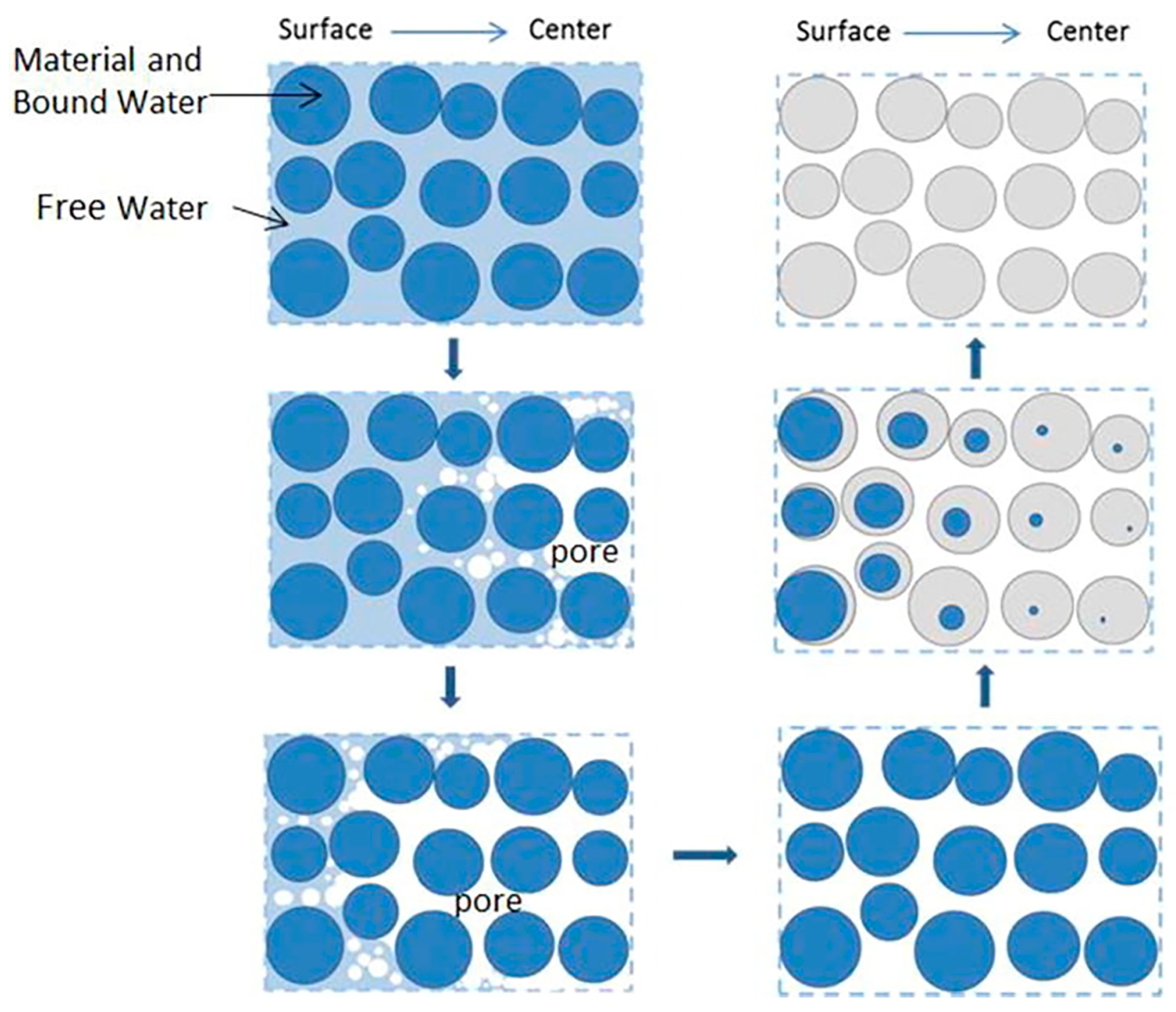Microwave Treatment of Minerals and Ores: Heating Behaviors, Applications, and Future Directions
Abstract
:1. Introduction
2. Principles of Microwave Heating
2.1. Material Absorption of Microwave Power
2.2. Dielectric Parameters
2.3. Material Heating Rate
2.4. Microwave Penetration Depth
- The first type is microwave-transparent, where the material does not absorb microwave energy, and no energy dissipation occurs within the object. The heated object does not increase in temperature, as shown in Figure 1a. Such materials are often used as containers for the materials to be heated (glass, ceramics, and plastics).
- The second is microwave-reflective, where the material acts like a mirror, reflecting all microwaves (as shown in Figure 1b) without absorbing microwave energy and, therefore, does not heat up. Most metallic materials belong to this category, and thus they are commonly used as waveguides or cavities in microwave heating equipment.
- The third is microwave-absorbing, where the material absorbs microwave energy, resulting in a temperature increase. Such materials are referred to as microwave absorbers (as shown in Figure 1c).

3. Heating Behaviors in Microwave Treatment
4. Applications of Microwave Treatment in Mineral Metallurgy
4.1. Ore Pre-Treatment
4.2. Mineral Processing
4.3. Hydrometallurgy
4.4. Smelting and Reduction
4.5. Drying
5. Future Directions and Research Opportunities
5.1. Enhanced Equipment Design
5.2. Process Optimization and Modeling
5.3. Integration with Conventional Methods
5.4. Technological Innovation
6. Conclusions
Author Contributions
Funding
Data Availability Statement
Acknowledgments
Conflicts of Interest
References
- Meshram, P.; Abhilash; Pandey, B.D. Advanced Review on Extraction of Nickel from Primary and Secondary Sources. Miner. Process. Extr. Metall. Rev. 2019, 40, 157–193. [Google Scholar] [CrossRef]
- Fortier, S.M.; Thomas, C.L.; McCullough, E.A.; Tolcin, A.C. Global Trends in Mineral Commodities for Advanced Technologies. Nat. Resour. Res. 2018, 27, 191–200. [Google Scholar] [CrossRef]
- Dubiński, J. Sustainable Development of Mining Mineral Resources. J. Sustain. Min. 2013, 12, 1–6. [Google Scholar] [CrossRef]
- Song, Y.; Huang, J.; Zhang, Y.; Wang, Z. Drivers of metal consumption in China: An input-output structural decomposition analysis. Resour. Policy 2019, 63, 101421. [Google Scholar] [CrossRef]
- Shengo, M.L.; Kime, M.B.; Mambwe, M.P.; Nyembo, T.K. A review of the beneficiation of copper-cobalt-bearing minerals in the Democratic Republic of Congo. J. Sustain. Min. 2019, 18, 226–246. [Google Scholar] [CrossRef]
- Elmahdy, A.M.; Miki, H.; Sasaki, K.; Farahat, M. The Effect of Microwave Pre-treatment on the Magnetic Properties of Enargite and Tennantite and Their Separation from Chalcopyrite. Minerals 2023, 13, 334. [Google Scholar] [CrossRef]
- Chen, G.; Ling, Y.; Li, Q.; Zheng, H.; Qi, J.; Li, K.; Chen, J.; Peng, J.; Gao, L.; Omran, M.; et al. Investigation on microwave carbothermal reduction behavior of low-grade pyrolusite. J. Mater. Res. Technol. 2020, 9, 7862–7869. [Google Scholar] [CrossRef]
- Shen, M.; Fu, L.; Tang, J.; Liu, M.; Song, Y.; Tian, F.; Zhao, Z.; Zhang, Z.; Dionysiou, D.D. Microwave hydrothermal-assisted preparation of novel spinel-NiFe2O4/natural mineral composites as microwave catalysts for degradation of aquatic organic pollutants. J. Hazard. Mater. 2018, 350, 1–9. [Google Scholar] [CrossRef]
- Kingman, S.W. Recent developments in microwave processing of minerals. Int. Mater. Rev. 2006, 51, 1–12. [Google Scholar] [CrossRef]
- He, F. Microwave-Enhanced Carbothermal Reduction of Low-Grade Pyrolusite Pellets. Master’s Thesis, Kunming University of Science and Technology, Kunming, China, 2019. [Google Scholar] [CrossRef]
- Ruan, S. Study on Process and Mechanism of Pyrolysis Separation of Arsenic and Sulfur from Slurry Electrolysis Residue of High Arsenic-Antimony Gold Sulfde Concentrates. Doctoral Thesis, University of Science and Technology Beijing, Beijing, China, 2022. [Google Scholar] [CrossRef]
- Ma, A.; Zheng, X.; Gao, L.; Li, K.; Omran, M.; Chen, G. Enhanced Leaching of Zinc from Zinc-Containing Metallurgical Residues via Microwave Calcium Activation Pretreatment. Metals 2021, 11, 1922. [Google Scholar] [CrossRef]
- Hidayat, M.I.P.; Felicia, D.M.; Rafandi, F.I.; Machmudah, A. Effects of Sample Shapes and Thickness on Distribution of Temperature inside the Mineral Ilmenite Due to Microwave Heating. Minerals 2020, 10, 382. [Google Scholar] [CrossRef]
- Yi, L.; Hao, H.; Shen, X.; Zhang, N.; Huang, Z. Drying and Roasting Characteristics of Iron Ore Pellets with Microwave Heating. JOM 2023, 75, 3709–3717. [Google Scholar] [CrossRef]
- Jena, S.K.; Dhawan, N.; Rath, S.S.; Rao, D.S.; Das, B. Investigation of microwave roasting for potash extraction from nepheline syenite. Sep. Purif. Technol. 2016, 161, 104–111. [Google Scholar] [CrossRef]
- Salakjani, N.K.; Singh, P.; Nikoloski, A.N. Acid roasting of spodumene: Microwave vs. conventional heating. Miner. Eng. 2019, 138, 161–167. [Google Scholar] [CrossRef]
- Rath, S.S.; Dhawan, N.; Rao, D.S.; Das, B.; Mishra, B.K. Beneficiation studies of a difficult to treat iron ore using conventional and microwave roasting. Powder Technol. 2016, 301, 1016–1024. [Google Scholar] [CrossRef]
- Henthorn, N.T.; Warmenhoven, J.W.; Sotiropoulos, M.; Aitkenhead, A.H.; Smith, E.A.K.; Ingram, S.P.; Kirkby, N.F.; Chadwick, A.L.; Burnet, N.G.; Mackay, R.I.; et al. Clinically relevant nanodosimetric simulation of DNA damage complexity from photons and protons. RSC Adv. 2019, 9, 6845–6858. [Google Scholar] [CrossRef] [PubMed]
- Choi, N.; Kim, B.; Cho, K.; Lee, S.; Park, C. Microwave Pretreatment for Thiourea Leaching for Gold Concentrate. Metals 2017, 7, 404. [Google Scholar] [CrossRef]
- Schmuhl, R.; Smit, J.T.; Marsh, J.H. The influence of microwave pre-treatment of the leach behaviour of disseminated sulphide ore. Hydrometallurgy 2011, 108, 157–164. [Google Scholar] [CrossRef]
- Yang, X.; Peng, J. New Application of Microwave Energy Technology; Yunnan Science and Technology Press: Kunming, China, 1997. [Google Scholar]
- Takatsu, K. Development of the microwave heated catalyst system. JSAE Rev. 1999, 20, 431–433. [Google Scholar] [CrossRef]
- Kobayashi, Y.; Katoh, M. Microwave measurement of dielectric properties of low-loss materials by the dielectric rod resonator method. IEEE 1985, 33, 586–592. [Google Scholar] [CrossRef]
- Gabriel, C.; Gabriel, S.; Corthout, E. The dielectric properties of biological tissues: I. Literature survey. Phys. Med. Biol. 1996, 41, 2231–2249. [Google Scholar] [CrossRef]
- Liu, C. Research on New Process of Microwave Heating Application Based on Dielectric Properties of Metallurgical Materials. Ph.D. Thesis, Kunming University of Science and Technology, Kunming, China, 2014. [Google Scholar]
- Peng, J.; Liu, B.; Zhang, L.; Zhou, J.; Xia, H.; Zhang, Z. Research status and trend of high-temperature microwave metallurgy reactor. Chin. J. Nonferr. Met. 2011, 21, 2607–2615. [Google Scholar] [CrossRef]
- Zhou, G.; Huang, Q.; Yu, B.; Tong, H.; Chi, Y.; Yan, J. Effect of industrial microwave irradiation on the physicochemical properties and pyrolysis characteristics of lignite. Chin. J. Chem. Eng. 2018, 26, 1171–1178. [Google Scholar] [CrossRef]
- Peng, Z.; Lin, X.; Wu, X.; Hwang, J.; Kim, B.; Zhang, Y.; Li, G.; Jiang, T. Microwave absorption characteristics of anthracite during pyrolysis. Fuel Process. Technol. 2016, 150, 58–63. [Google Scholar] [CrossRef]
- Wang, J.; Jiang, T.; Liu, Y.; Xue, X. Influence of microwave treatment on grinding and dissociation characteristics of vanadium titano-magnetite. Int. J. Miner. Metall. Mater. 2019, 26, 160–167. [Google Scholar] [CrossRef]
- Hou, M.; Li, J.; Yang, L.; Fang, P.; Guo, S.; Yan, Y. Study of Effect of Pulsed Microwave Assisted Grinding Process Parameters on the Ilmenite Heating Performance. Gold Sci. Technol. 2020, 28, 595–602. [Google Scholar]
- Pickles, C.; Lu, T. Microwave Dewatering of Gibbsite-Type Bauxite Ores: Permittivities, Heating Behavior and Strength Indices. Minerals 2022, 12, 648. [Google Scholar] [CrossRef]
- Forster, J.; Elliott, R.; Boucher, D.; Bobicki, E.R. High-Temperature microwave properties and phase transitions of ultramafic nickel ores. Miner. Eng. 2021, 172, 107109. [Google Scholar] [CrossRef]
- Chen, J.; Li, L.; Chen, G.; Peng, J.; Srinivasakannan, C. Rapid thermal decomposition of manganese ore using microwave heating. J. Alloys Compd. 2017, 699, 430–435. [Google Scholar] [CrossRef]
- Bai, T.; Lei, H.; Lei, Z.; Li, S. Dearsenification of gold concentrates via microwave roasting. Can. Metall. Q. 2020, 59, 60–66. [Google Scholar] [CrossRef]
- Li, K.; Chen, J.; Peng, J.; Omran, M.; Chen, G. Efficient improvement for dissociation behavior and thermal decomposition of manganese ore by microwave calcination. J. Clean. Prod. 2020, 260, 121074. [Google Scholar] [CrossRef]
- Li, K.; Chen, G.; Chen, J.; Peng, J.; Ruan, R.; Srinivasakannan, C. Microwave pyrolysis of walnut shell for reduction process of low-grade pyrolusite. Bioresour. Technol. 2019, 291, 121838. [Google Scholar] [CrossRef]
- Zhao, Q.H.; Zhao, X.B.; Zheng, Y.L.; Li, J.C.; He, L.; He, J.L.; Zou, C.J. Heating characteristics of igneous rock-forming minerals under microwave irradiation. Int. J. Rock Mech. Min. Sci. 2020, 135, 104519. [Google Scholar] [CrossRef]
- Yuan, Y.; Shao, Z.; Qiao, R.; Fei, X.; Cheng, J. Thermal response and crack propagation of mineral components in olivine basalt under microwave irradiation. Arab. J. Geosci. 2020, 13, 589. [Google Scholar] [CrossRef]
- Lovas, M.; Znamenáčková, I.; Zubrik, A.; Kováčová, M.; Dolinská, S. The Application of Microwave Energy in Mineral Processing—A Review. Acta Montan. Slovaca 2011, 16, 137–148. Available online: https://www.researchgate.net/publication/266873018 (accessed on 1 December 2023).
- Kingman, S.W.; Rowson, N.A. Microwave treatment of minerals—A review. Miner. Eng. 1998, 11, 1081–1087. [Google Scholar] [CrossRef]
- He, F.; Ma, B.; Wang, C.W.; Ma, Y.M.; Asselin, E.; Chen, Y.C.; Zhang, W.Z.; Zhao, J.Z. Microwave pretreatment for enhanced selective nitric acid pressure leaching of limonitic laterite. J. Cent. South Univ. 2021, 28, 3050–3060. [Google Scholar] [CrossRef]
- Kumar, P.; Sahoo, B.K.; De, S.; Kar, D.D.; Chakraborty, S.; Meikap, B.C. Iron ore grindability improvement by microwave pre-treatment. J. Ind. Eng. Chem. 2010, 16, 805–812. [Google Scholar] [CrossRef]
- Bobicki, E.; Liu, Q.; Xu, Z. Microwave Treatment of Ultramafic Nickel Ores: Heating Behavior, Mineralogy, and Comminution Effects. Minerals 2018, 8, 524. [Google Scholar] [CrossRef]
- Yan, Y.; Chen, K.; Chen, J.; Guo, S. Comparative study on microwave-assisted grinding of low-grade magnetite by continuous heating and pulsed heating. Chin. J. Nonferr. Met. 2022, 32, 883–894. [Google Scholar] [CrossRef]
- Pickles, C.A. Microwaves in extractive metallurgy: Part 2—A review of applications. Miner. Eng. 2009, 22, 1112–1118. [Google Scholar] [CrossRef]
- Le, T.; Ju, S.; Lu, L.; Peng, J.; Zhou, L.; Wang, S. A novel process and its mechanism for recovering alumina from diasporic bauxite. Hydrometallurgy 2017, 169, 124–134. [Google Scholar] [CrossRef]
- Cai, X.; Qian, G.; Zhang, B.; Chen, Q.; Hu, C. Selective Liberation of High-Phosphorous Oolitic Hematite Assisted by Microwave Processing and Acid Leaching. Minerals 2018, 8, 245. [Google Scholar] [CrossRef]
- Li, S.; Zhang, Y.; Yuan, Y.; Hu, P. An insight on the mechanism of efficient leaching of vanadium from vanadium shale induced by microwave-generated hot spots. Int. J. Miner. Metall. Mater. 2023, 30, 293–302. [Google Scholar] [CrossRef]
- Du, J.; Yang, Y.; Omran, M.; Guo, S. Research Status and Progress of Microwave Associated Leaching. Curr. Microw. Chem. 2021, 8, 7–11. [Google Scholar] [CrossRef]
- Lin, S.; Gao, L.; Yang, Y.; Chen, J.; Guo, S.; Omran, M.; Chen, G. Efficiency and sustainable leaching process of manganese from pyrolusite-pyrite mixture in sulfuric acid systems enhanced by microwave heating. Hydrometallurgy 2020, 198, 105519. [Google Scholar] [CrossRef]
- Lin, S.; Li, K.; Yang, Y.; Gao, L.; Omran, M.; Guo, S.; Chen, J.; Chen, G. Microwave-assisted method investigation for the selective and enhanced leaching of manganese from low-grade pyrolusite using pyrite as the reducing agent. Chem. Eng. Process.—Process Intensif. 2021, 159, 108209. [Google Scholar] [CrossRef]
- Choi, J.; Bediako, J.K.; Kang, J.; Lim, C.; Dangi, Y.R.; Kim, H.; Cho, C.; Yun, Y. In-situ microwave-assisted leaching and selective separation of Au(III) from waste printed circuit boards in biphasic aqua regia-ionic liquid systems. Sep. Purif. Technol. 2021, 255, 117649. [Google Scholar] [CrossRef]
- Agrawal, S.; Dhawan, N. Investigation of carbothermic microwave reduction followed by acid leaching for recovery of iron and aluminum values from Indian red mud. Miner. Eng. 2020, 159, 106653. [Google Scholar] [CrossRef]
- Zhou, W.; Sun, Y.; Han, Y.; Gao, P.; Li, Y. Recycling iron from oolitic hematite via microwave fluidization roasting and magnetic separation. Miner. Eng. 2021, 164, 106851. [Google Scholar] [CrossRef]
- Li, K.; Chen, J.; Peng, J.; Ruan, R.; Srinivasakannan, C.; Chen, G. Pilot-scale study on enhanced carbothermal reduction of low-grade pyrolusite using microwave heating. Powder Technol. 2020, 360, 846–854. [Google Scholar] [CrossRef]
- Idris, A.; Khalid, K.; Omar, W. Drying of silica sludge using microwave heating. Appl. Therm. Eng. 2004, 24, 905–918. [Google Scholar] [CrossRef]
- Pickles, C.A.; Gao, F.; Kelebek, S. Microwave drying of a low-rank sub-bituminous coal. Miner. Eng. 2014, 62, 31–42. [Google Scholar] [CrossRef]
- Guo, L.; Zhang, L.; Peng, J.; Duan, X.; Wang, X. An optimization study of microwave drying process for scheelite concentrate with RSM. Min. Metall. 2012, 21, 54–57. [Google Scholar] [CrossRef]
- Zhang, Y.; Zhang, Z.; Yuan, X.; You, X.; Liu, Z. Microwave-drying process and mineral phase analysis of low-grade complex laterite ores. J. Univ. Sci. Technol. Beijing 2010, 32, 1119–1123. [Google Scholar] [CrossRef]
- Du, J.; Gao, L.; Yang, Y.; Guo, S.; Chen, J.; Omran, M.; Chen, G. Modeling and kinetics study of microwave heat drying of low grade manganese ore. Adv. Powder Technol. 2020, 31, 2901–2911. [Google Scholar] [CrossRef]
- Jones, D.A.; Kingman, S.W.; Whittles, D.N.; Lowndes, I.S. The influence of microwave energy delivery method on strength reduction in ore samples. Chem. Eng. Process. Process Intensif. 2007, 46, 291–299. [Google Scholar] [CrossRef]
- Kinoshita, T.; Sugihashi, A. Design and optimization of a slot antenna for microwave heating of agglomerates. COMPEL—Int. J. Comput. Math. Electr. Electron. Eng. 2018, 37, 1886–1892. [Google Scholar] [CrossRef]
- Pressacco, M.; Kangas, J.J.J.; Saksala, T. Numerical modelling of microwave irradiated rock fracture. Miner. Eng. 2023, 203, 108318. [Google Scholar] [CrossRef]
- Kovaleva, L.; Zinnatullin, R.; Musin, A.; Kireev, V.; Karamov, T.; Spasennykh, M. Investigation of Source Rock Heating and Structural Changes in the Electromagnetic Fields Using Experimental and Mathematical Modeling. Minerals 2021, 11, 991. [Google Scholar] [CrossRef]
- Raveendran, A.; Sebastian, M.T.; Raman, S. Applications of Microwave Materials: A Review. J. Electron. Mater. 2019, 48, 2601–2634. [Google Scholar] [CrossRef]
- Qoidah, S.N.; Ulfawanti Intan Subadra, S.; Taufiq, A.; Mufti, N.; Sunaryono, S.; Hidayat, N.; Handoko, E.; Alaydrus, M.; Amrillah, T. Fe3O4/MWCNT/TiO2 nanocomposites as excellent microwave absorber material. J. Alloys Compd. 2024, 970, 172590. [Google Scholar] [CrossRef]





Disclaimer/Publisher’s Note: The statements, opinions and data contained in all publications are solely those of the individual author(s) and contributor(s) and not of MDPI and/or the editor(s). MDPI and/or the editor(s) disclaim responsibility for any injury to people or property resulting from any ideas, methods, instructions or products referred to in the content. |
© 2024 by the authors. Licensee MDPI, Basel, Switzerland. This article is an open access article distributed under the terms and conditions of the Creative Commons Attribution (CC BY) license (https://creativecommons.org/licenses/by/4.0/).
Share and Cite
Chen, J.; Li, X.; Gao, L.; Guo, S.; He, F. Microwave Treatment of Minerals and Ores: Heating Behaviors, Applications, and Future Directions. Minerals 2024, 14, 219. https://doi.org/10.3390/min14030219
Chen J, Li X, Gao L, Guo S, He F. Microwave Treatment of Minerals and Ores: Heating Behaviors, Applications, and Future Directions. Minerals. 2024; 14(3):219. https://doi.org/10.3390/min14030219
Chicago/Turabian StyleChen, Jin, Xinpei Li, Lei Gao, Shenghui Guo, and Fei He. 2024. "Microwave Treatment of Minerals and Ores: Heating Behaviors, Applications, and Future Directions" Minerals 14, no. 3: 219. https://doi.org/10.3390/min14030219






